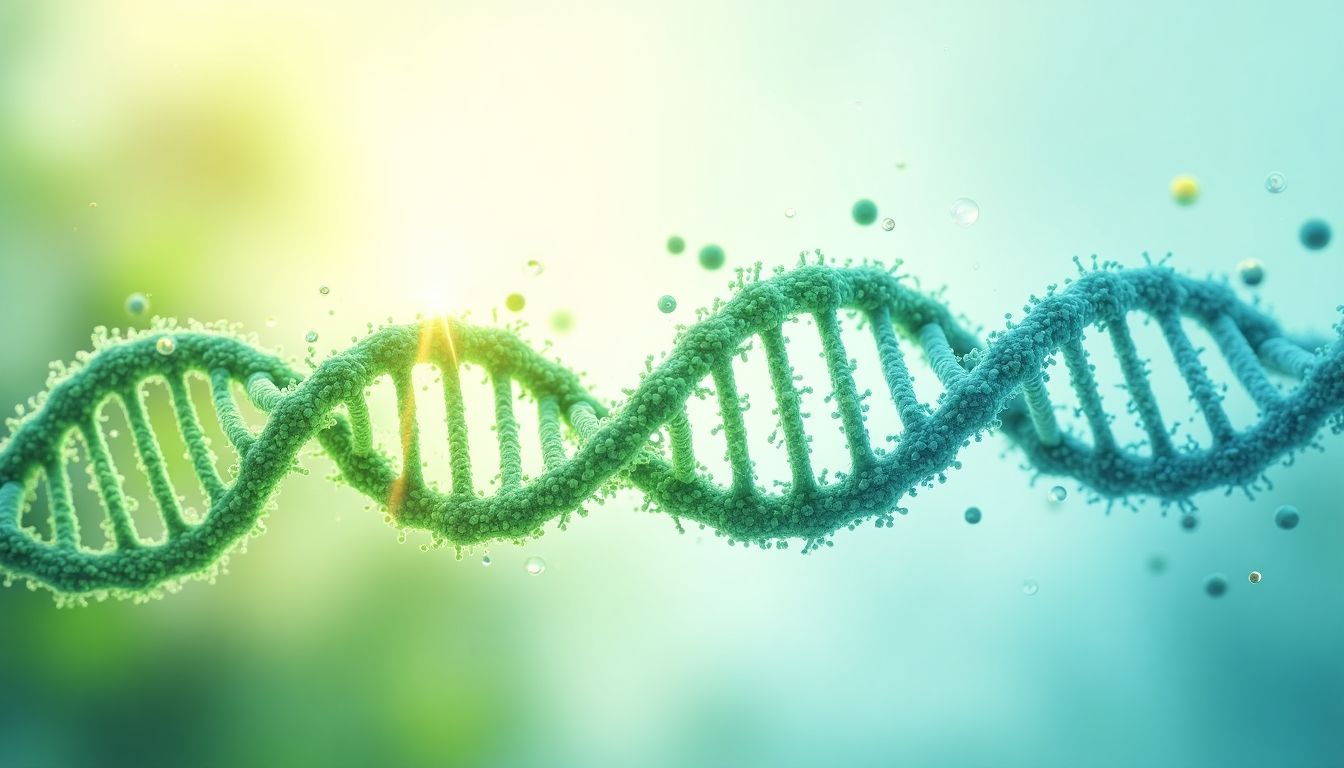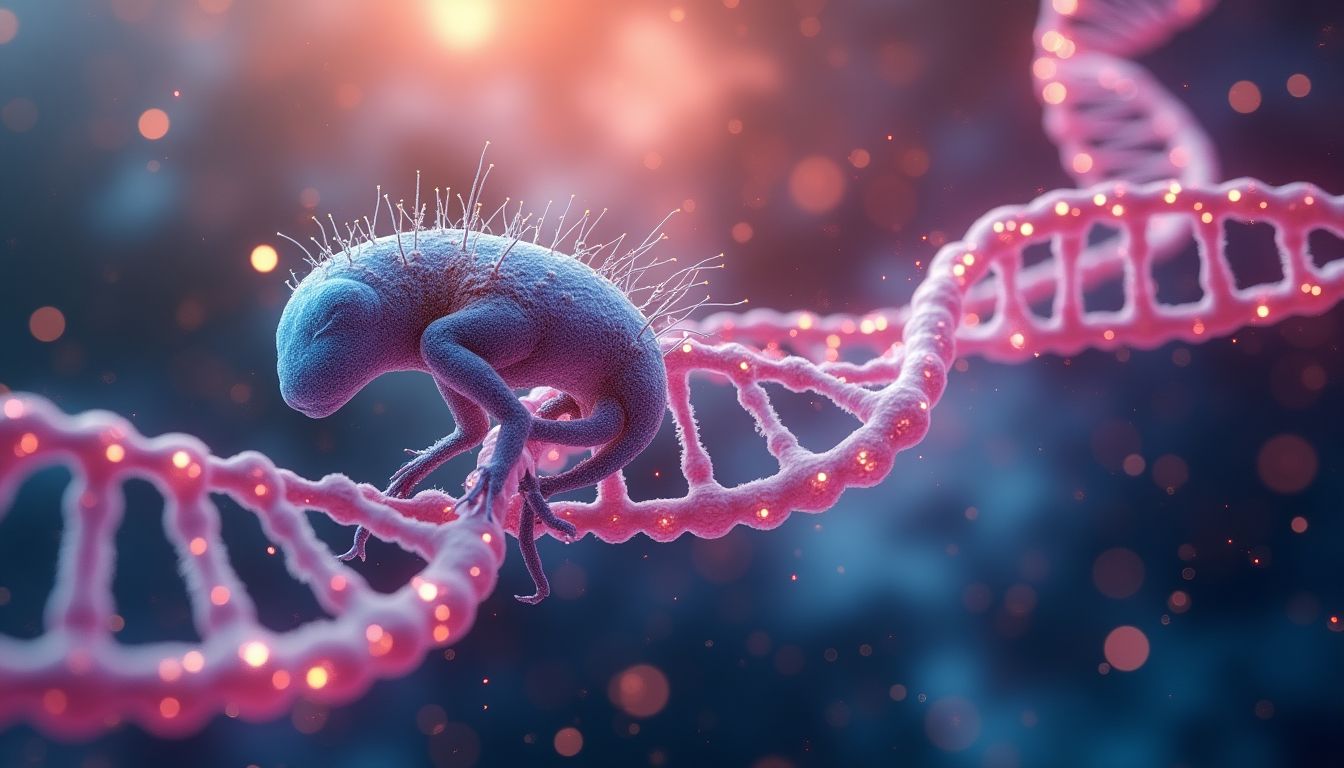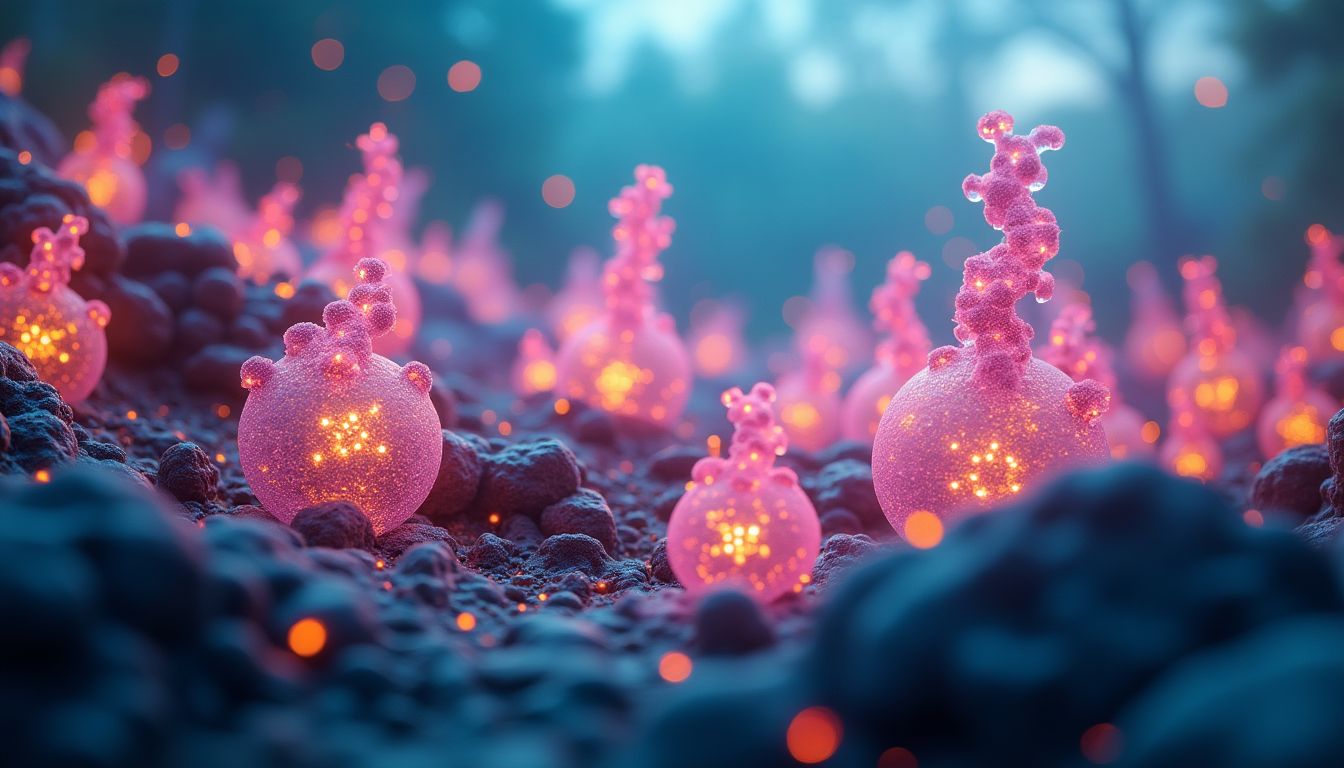Introduction: The Genesis of Tomorrow
Nature does not hurry, yet everything is accomplished. — Lao Tzu
This quote reminds us that nature, in all its complexity, has a way of balancing itself and moving forward—even when things seem chaotic. Just like the intricate dance of ecosystems, the fusion of artificial intelligence and genetic engineering is emerging at a breakneck pace. The idea of using AI to design new species may seem far-fetched, but in a world grappling with climate change and ecological degradation, it offers a glimmer of hope. Could we be standing at the forefront of a scientific revolution that not only mends our planet but also redefines the rules of life itself? The question isn’t whether we can do this; it's whether we *should*.
As authors like Richard Dawkins have pondered the ethics of genetic manipulation and luminaries such as E.O. Wilson have celebrated biodiversity, AI's revolutionary role in creating new species begs deeper contemplation. This fascinating intersection of technology and biology doesn’t just challenge conventional wisdom; it challenges us. What if we could design organisms that could reverse environmental damage? How do we tread that fine line between innovation and ethical responsibility?
1. The Convergence of AI and Genetic Engineering
The integration of artificial intelligence into genetic engineering is not merely a trend; it’s a paradigm shift that stands to revolutionize how we approach biological life. We live in an age where algorithms can analyze massive datasets at lightning speed, uncovering patterns in our DNA that are akin to finding hidden treasures in a jumbled attic. Ever heard of the term "big data"? It’s like being able to hear every whisper of nature and decode its secrets! AI’s ability to predict gene functionalities means scientists are no longer fumbling in the dark but using laser pointers to illuminate the most promising paths.
1.1 Historical Context
Historically, the quest for understanding genetics has faced hurdles akin to climbing Mount Everest blindfolded. The double helix structure of DNA was first described by James Watson and Francis Crick in 1953, and since then, scientists have been racing to decipher and manipulate the building blocks of life. Fast forward to the 21st century, and CRISPR technology burst onto the scene like a superhero emerging from a comic book. This revolutionary tool allows scientists to edit genes with precision, effectively letting them play God—if only God had a degree in molecular biology and access to high-speed internet!
1.2 Current State of AI in Biotechnology
In the present day, AI is no longer just a buzzword; it's a bona fide game-changer in biotechnology. Companies like Ginkgo Bioworks are utilizing AI to streamline the process of organism design, making it faster and more efficient. With machine learning algorithms, researchers can identify which genetic modifications are most likely to succeed. So, while you might be trying to figure out how to make a perfect chocolate chip cookie, scientists are busy crafting organisms that can thrive in polluted water or absorb greenhouse gases like they’re made of organic cotton candy. Sweet, right?
2. The Potential for New Species Creation
Armed with AI, scientists are now envisioning organisms custom-tailored for specific environmental challenges. Through techniques like CRISPR and synthetic biology, new species can be designed to mitigate the effects of pollution, restore depleted ecosystems, or even sequester carbon at unprecedented rates. Fancy that! Imagine a world where organisms are not just surviving but thriving and contributing to the environments we’ve hurt.
-
- 2.1 Case Studies of Successful Species Creation
Let’s dive into some real-life examples. One prime instance is the genetically modified drought-resistant corn developed through the combination of genetic engineering and AI technology. This corn can grow in inhospitable conditions, helping farmers in regions affected by climate change. Another example is the work being done with CRISPR-modified mosquitoes that are engineered to fight diseases like malaria. Imagine a world where mosquitoes can not only annoy you but also assist you in staying healthy—what a twist! These cases showcase how AI-driven gene crafting can create truly impactful organisms that benefit both nature and society.
-
- 2.2 Ethical Implications and Controversies
Of course, where there’s innovation, there’s a need for ethical reflection. Concerns often arise about the potential risks of creating invasive species. It’s a bit like inviting a new friend to a party and finding out they’ve brought along their even more disruptive cousin. The unpredictability of how these engineered organisms might interact with ecosystems is a valid worry, and it raises the age-old question: are we 'playing God'? As we tread these murky waters, transparent dialogue and thorough testing can help ease fears. After all, the last thing we want is a new species suddenly deciding they’re the rulers of the environment.
3. Practical Applications in Environmental Restoration
This section highlights practical examples of how AI-created organisms can address environmental degradation. From designing algae that cleans water bodies to creating plants that flourish in arid conditions, the applications are only bound by our imagination. Let’s unleash the possibilities!
-
- 3.1 Algae for Water Filtration
Picture a slimy green superhero—yes, algae! Through AI-enhanced genetic modifications, scientists are designing algae that can absorb pollutants, making our water bodies cleaner. This process is akin to Mother Nature getting a bit of a high-tech makeover. Researchers at the University of California are already using such organisms to remediate contaminated waters, leading to clearer rivers and lakes. It’s like giving nature a detox therapy session!
-
- 3.2 Drought-Resistant Crops
With climate change making droughts more common, what could be better than crops that can withstand these conditions? Engineers are working hard, using AI to develop plants that need little water and can grow in otherwise barren fields. The Bayer Crop Science division has been at the forefront. Imagine farmers not having to worry about their crops drying out like last week’s leftovers in the fridge. It’s a game changer for food security and environmental health!
4. Challenges in Implementation and Public Acceptance
As exciting as the potential of AI-driven gene crafting is, we must not turn a blind eye to the challenges that stand in the way. There are significant hurdles that researchers and advocates need to overcome before this ambitious technology can take flight. Let's dive into two major areas of concern that have sparked debate:
- 4.1 Addressing Public Concerns
- 4.2 Navigating Regulatory Landscapes
4.1 Addressing Public Concerns
Public skepticism is a formidable barrier when it comes to adopting new technologies. Many people are rightfully cautious, given the unforeseen consequences that can arise from genetic manipulation. Consider this:
- Fear of Unintended Consequences: The idea of introducing engineered organisms into the wild can trigger fears of ecological imbalance. For example, genetically modified crops have faced backlash over concerns they could crossbreed with wild species, leading to unpredictable outcomes.
- Ethical Concerns: Questions about 'playing God' often arise. The ethics of creating new life forms and the responsibility that comes with it are hotly debated topics that need to be addressed transparently.
- Lack of Understanding: Many people may not fully grasp how AI and genetic engineering work. This knowledge gap can lead to misinformation and mistrust.
To counter these concerns, clear communication is crucial. Collaborations with prominent organizations such as Nature and public educational campaigns can help demystify the science. Creating open forums where scientists and the public can engage is another way to foster understanding and build trust.
4.2 Navigating Regulatory Landscapes
Like a tightrope walker balancing above a deep canyon, the path to regulatory approval can be tricky. Governments around the world have different stances on genetic engineering, with varying regulations that may slow down progress.
Some key points to consider include:
- Varied Regulations by Region: Different countries have distinct legal frameworks governing genetically modified organisms (GMOs). For instance, the USDA has different criteria than the EU, leading to confusion for scientists aiming for international collaboration.
- Long Approval Processes: Obtaining the necessary permits for research can take months, often resulting in wasted time and resources.
- Collaboration with Policymakers: To navigate this complexity, scientists must engage with regulators early on, emphasizing the safety and benefits of AI-driven gene crafting.
5. Future Innovations in AI and Biotechnology
The field of AI and biotechnology is continuously evolving, and the future holds exciting potential for breakthroughs that could reshape our world. Let's take a closer look at what innovations might be on the horizon:
- 5.1 Emerging Technologies
- 5.2 Potential Impacts on Global Biodiversity
5.1 Emerging Technologies
Scientists are developing a range of innovative tools that could enhance our ability to create functional organisms. Some key developments include:
- Organoid Engineering: This technique involves creating miniaturized, simplified organs in the lab. This could lead to breakthroughs in understanding disease and developing treatments.
- Gene Drives: A powerful tool that can spread a specific genetic trait throughout a population, gene drives could help control invasive species that threaten local ecosystems.
- Cloud-based Genetic Algorithms: These sophisticated algorithms allow global collaboration amongst researchers, making it easier to share data and innovations across borders.
These technologies can combine to create more resilient species, tailored to combat specific ecological challenges.
5.2 Potential Impacts on Global Biodiversity
The potential impacts of these technologies on global biodiversity are profound. Imagine a world where:
- Restoration of Ecosystems: Engineered organisms can help revive habitats that have been degraded from pollution and climate change.
- Balanced Food Production: Crops that can withstand extreme weather conditions not only secure food supplies but also reduce the need for pesticides, supporting biodiversity.
- Enhanced Carbon Sequestration: New species designed to absorb carbon from the atmosphere might play a crucial role in combating climate change.
As we venture into this new frontier, it is essential that we approach these challenges with optimism while remaining vigilant to the responsibilities that lie ahead.
6. AI Solutions: How Would AI Tackle This Issue?
If I were an AI designed to guide the development of new species for environmental restoration, I would adopt a systematic approach to ensure the best possible outcomes. Here's how I would navigate the complexities of AI-driven genetic engineering:
-
- 6.1 Data Collection and Analysis
First, I would establish a robust framework for data collection. This would involve gathering extensive datasets from genomic sequencing, environmental conditions, biodiversity records, and historical ecological data. Sourcing information from reputable databases like the National Center for Biotechnology Information (NCBI) and the Global Biodiversity Information Facility (GBIF) would provide a solid foundation for analysis.
-
- 6.2 Collaboration with Biologists
Next, I would collaborate closely with biologists and ecologists. Their expertise is essential to create an interdisciplinary team, fostering strong communication between AI and human scientists. This ensures that the AI grasps the nuances of ecosystems while identifying critical areas for intervention.
-
- 6.3 Genetic Mapping and Predictive Models
Utilizing machine learning techniques, I would develop genetic mapping tools that reveal the functions of specific genes and their interactions with various environmental factors. By constructing predictive models, I could simulate potential genetic modifications' biological and ecological effects before implementation.
-
- 6.4 Development of Prototype Organisms
Finally, I would focus on designing and evaluating prototype organisms. Utilizing methods like CRISPR gene editing, I would create small-scale prototypes that could be tested in controlled environments to analyze their effectiveness in addressing specific ecological issues.
Actions Schedule/Roadmap (Day 1 to Year 2)
This roadmap outlines a strategic approach to integrating AI-driven genetic engineering for environmental restoration. It serves as a guide for institutions, organizations, or governments wishing to embark on this transformative journey:
Day 1: Convene an initial project meeting with stakeholders, including geneticists, ecologists, AI specialists, and policymakers. Establish project goals and assign responsibilities.
Day 2: Form a multi-disciplinary team comprising experts from biotechnology, environmental science, computer science, ethics, and public policy.
Day 3: Begin curating and consolidating relevant biological datasets while setting up secure data storage and sharing systems. Utilize platforms like Data.world for collaboration.
Week 1: Implement machine learning models to analyze the assembled genetic datasets. Leverage existing frameworks like Scikit-learn for predictive analytics.
Week 2: Conduct preliminary assessments of the ecological landscapes affected. Initiate meetings with regulatory bodies and ethics boards, such as the American Association for the Advancement of Science (AAAS), to discuss compliance and ethical considerations.
Week 3: Begin the development of predictive modeling frameworks that simulate the impact of genetic modifications on specific species and ecosystems.
Month 1: Conduct initial field tests using engineered organisms in small controlled environments, collecting data on their effectiveness in addressing environmental challenges.
Month 2: Analyze data from field tests, identifying aspects of the prototypes that require refinement. Prepare a progress report for stakeholders.
Month 3: Expand collaborations with ecological organizations. Engage grassroots initiatives and locally affected communities to gain public insights and foster acceptance.
Year 1: Scale successful prototypes based on the findings from initial tests, moving towards larger experimental designs that can be implemented in diverse ecological settings.
Year 1.5: Initiate large-scale environmental trials in collaboration with existing restoration projects. Reach out to organizations such as The Nature Conservancy for partnership opportunities.
Year 2: Full implementation of engineered organisms in targeted areas, focusing on ongoing monitoring, evaluation, and adjustment based on ecological feedback and results. Set up an ongoing dialog with local communities and experts for continuous improvement.
Conclusion: Bridging the Gap between Intention and Impact
As we stand on the edge of an innovative frontier where artificial intelligence intersects with genetic engineering, we must recognize the profound potential of our choices. This transformative technology could reshape our relationship with the natural world. However, with great potential comes a great responsibility. The journey ahead requires careful navigation through uncharted waters, balancing ambition with ethical considerations.
Imagine a future where our deliberate and informed choices lead to thriving ecosystems, restoring the planet's beauty and functionality through ingenious AI-crafted solutions. It's not just about crafting new species; it's about rekindling our connection to nature, reigniting hope for future generations. In the end, we will stand not as conquerors of nature but as partners in a grand, evolving narrative. This is our opportunity to rise as responsible stewards of Earth, reclaiming our role in the grand tapestry of life.
Frequently Asked Questions
- What is AI-driven genetic engineering?
AI-driven genetic engineering is a way to use computers and algorithms to help scientists design and change living organisms. It combines artificial intelligence with traditional methods of altering genes, allowing researchers to make better decisions about which changes might work best to solve environmental problems.
- Why is it important to create new species using AI?
Creating new species can help restore damaged ecosystems and tackle urgent environmental issues. For instance, AI can help design plants that survive in tough conditions or microorganisms that can clean polluted water. This technology offers hope for reversing some of the damage caused by humans to our planet.
- Are there any risks associated with AI-driven genetic engineering?
Yes, there are concerns about the potential risks. Creating new species could lead to unintended consequences, such as the new organisms causing harm to existing ecosystems. It's crucial to carefully study these risks before releasing engineered species into nature.
- What are gene drives and how do they work?
Gene drives are special tools in genetic engineering that force specific traits to spread through a population more quickly than usual. This can be used to control populations of invasive species or help endangered species survive better. For more information, you can check out the Wikipedia page on gene drives.
- How can we ensure the safe use of innovative genetic engineering?
To ensure safety, scientists and regulators must come together to create guidelines for testing and monitoring new species. Being transparent with the public can also build trust and handle concerns. Educational forums about the benefits and risks can better inform everyone.
- How is public opinion shaped regarding these technologies?
Public opinion can be influenced by education, media coverage, and involvement in discussions. When communities understand the science behind AI-driven genetic engineering and its potential benefits, they are more likely to support innovation while raising valid concerns.
- What roles do AI and genetic engineering play in combating climate change?
AI and genetic engineering can help combat climate change through creating organisms that capture carbon, restore ecosystems, and increase biodiversity. Innovations in these areas could lead to large-scale changes that improve environmental resilience.
- Where can I learn more about the intersection of AI and biotechnology?
To dive deeper into this exciting field, consider visiting resources like the Nature Biotechnology journal or the GenomeWeb website for the latest research and news.
- What kind of species could scientists create with AI?
Scientists could create a variety of species when using AI, such as:
- Plants that can grow in dry climates.
- Algae that can filter and clean water.
- Insects that serve specific roles in ecosystems, such as pollination without harming crops.
Wait! There's more...check out our gripping short story that continues the journey: A New Genesis
Disclaimer: This article may contain affiliate links. If you click on these links and make a purchase, we may receive a commission at no additional cost to you. Our recommendations and reviews are always independent and objective, aiming to provide you with the best information and resources.
Get Exclusive Stories, Photos, Art & Offers - Subscribe Today!





























1 comment